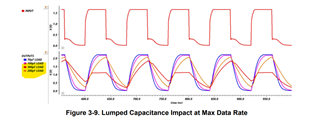Other Parts Discussed in Thread: TXS-EVM, LSF0002, TCA9517A
Tool/software:
Hello E2E Community,
Can we use this part for 1kHz I2C signals level translation when one side of the device may have upto 400pF of capacitance (mainly CAT6 cable)?
My concern arises due to specific mentions of One Shot related ringing & <70pF capacitance, but our data speed is very low (~1kHz).
We would be able to install RC Filter if possible on the field side cable at the device input.
Our intention is to create a sacrificial IC between the cable side & the MCU pins. We will install TVS Diodes (TDS05) on the inputs - I did not see input clamp diodes to VCC on this device family - will the 7-9V clamping of this TVS affect the safety of the device - we expect surge of few microseconds in 7-9V during TVS clamping events.
Requirement is to interface an external I2C Temperature sensor to the MCU via some sacrificial device.


